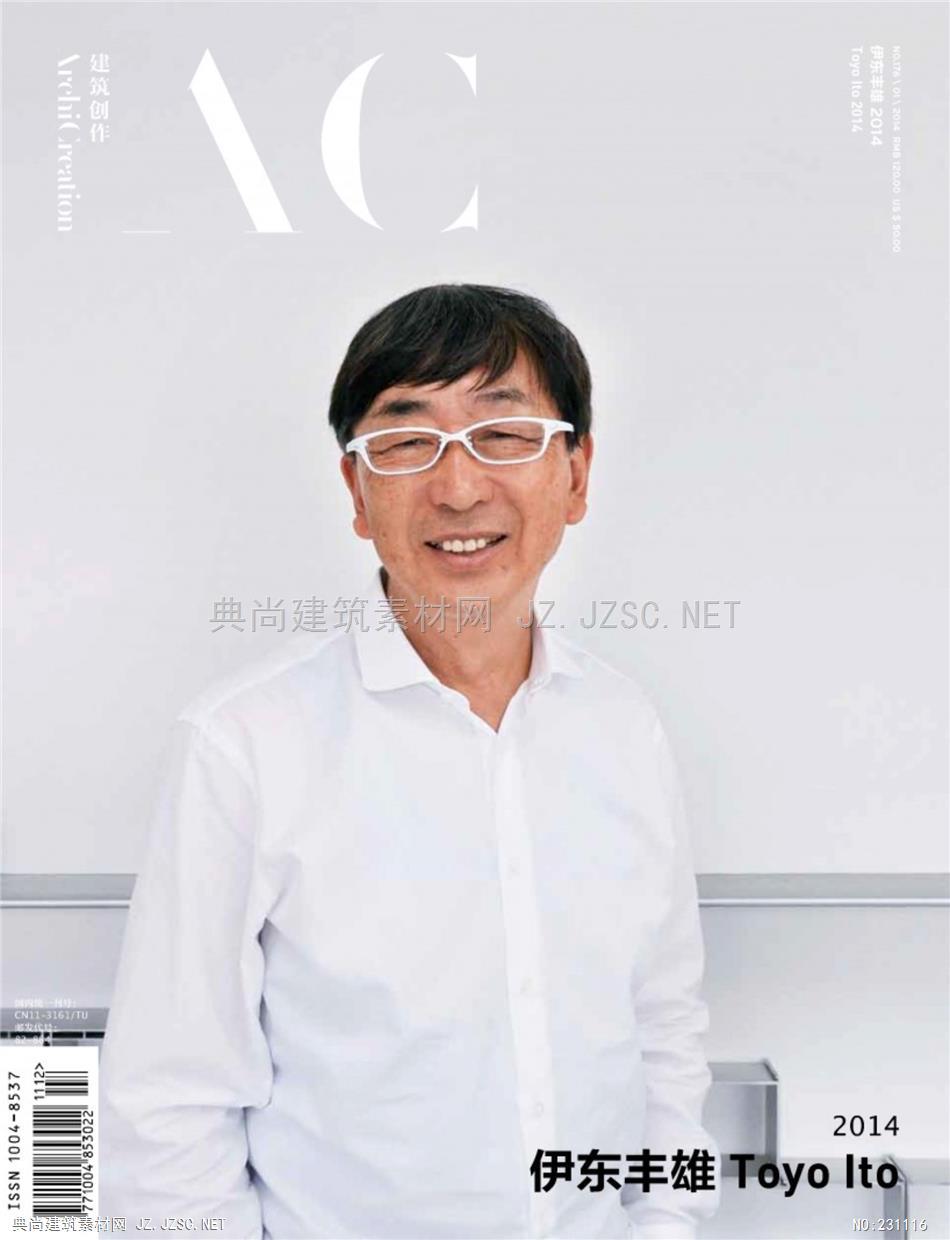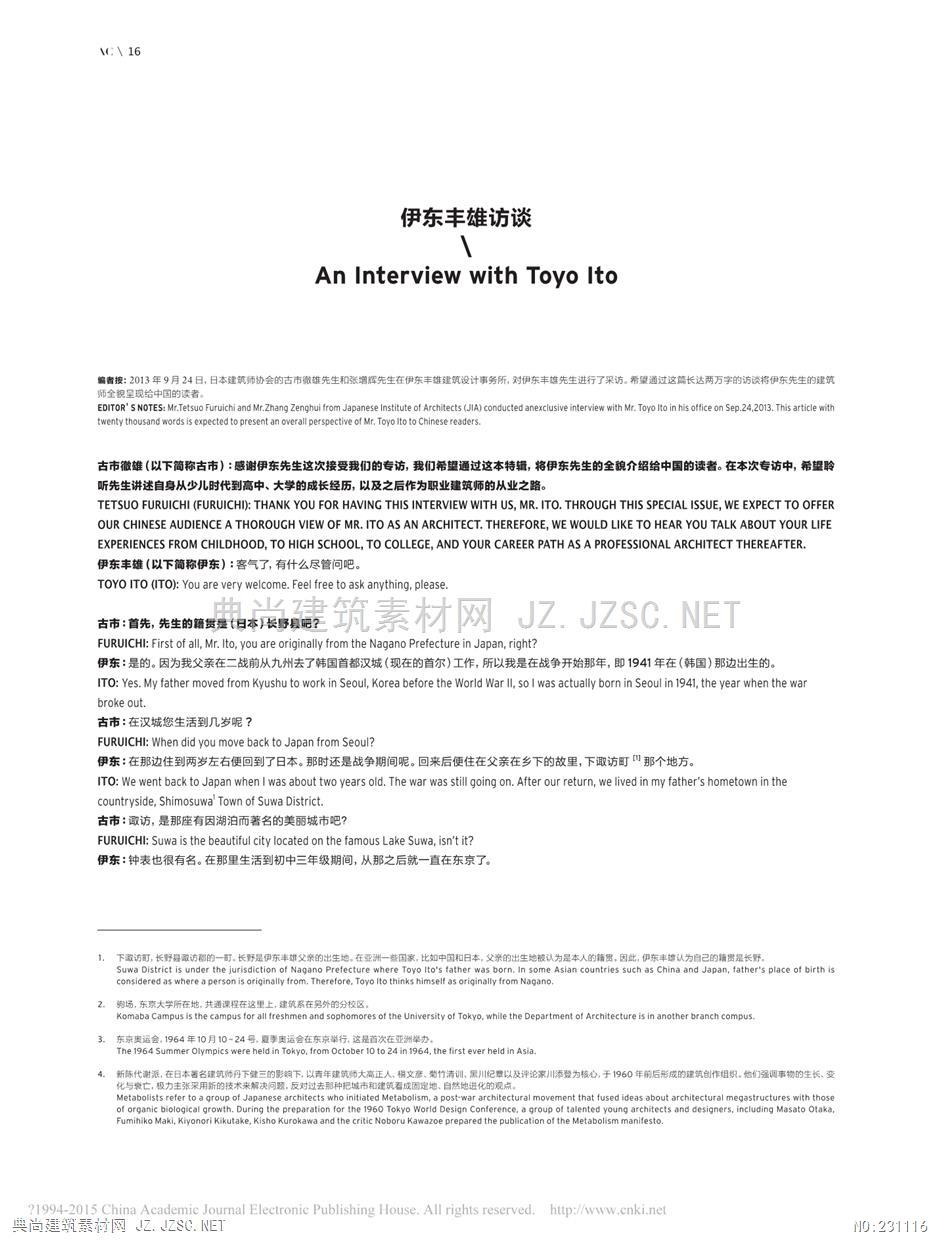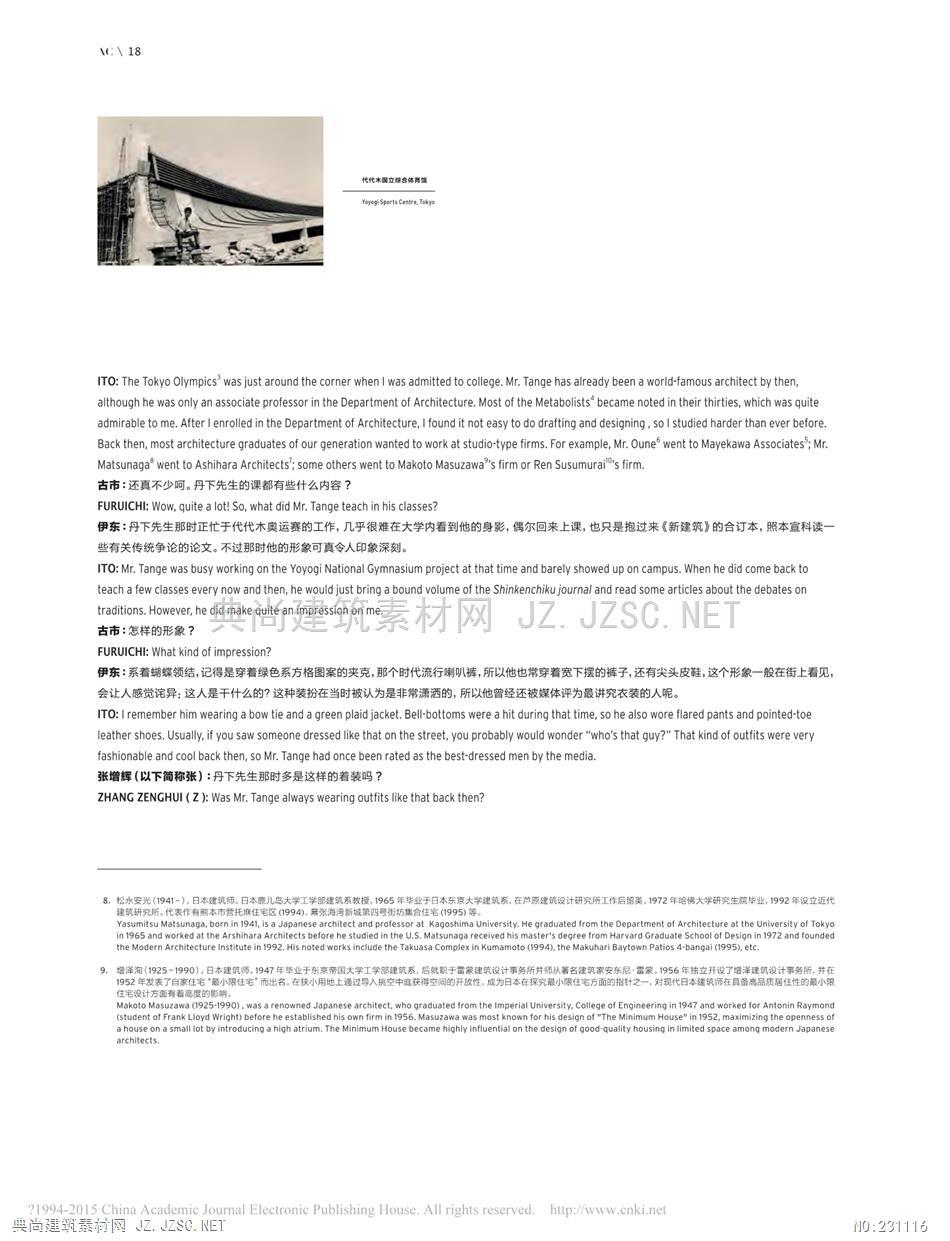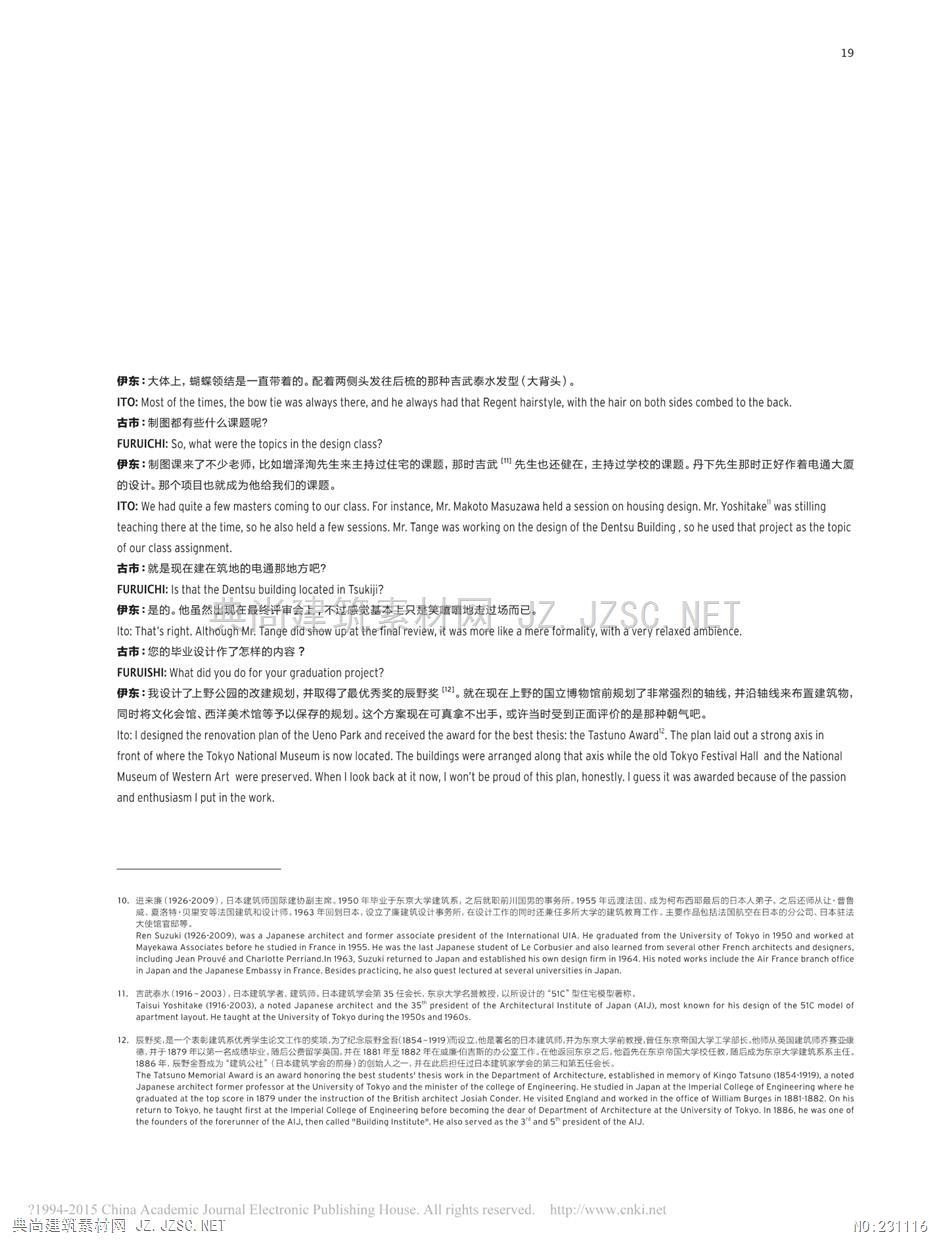









编者的话EDITORIAL伊东丰雄特辑Special issue on Toyo Ito2014年第一期AC《筑创作》杂志,是日本著名筑师伊东丰雄的专辑。专辑包括对伊东丰雄的长篇采访、山本理显及五十岚太郎撰写的评论、伊东本人的三篇署名文章、以及他的最新作品和经典项目共计22个本篇采访来自日本筑史家古市彻雄,描述了伊东从青少年时代、历经日本社会的多次变化、逐渐成熟、直至成为世界知名筑大师的成长历程,清晰地揭示了日本筑文化土壤中一位个体筑师的发展之路,《仙台之行》是在311日本大地震后实地考察灾情时,伊东发给日本筑界同行的信函,随笔式的短文却透露了筑师对筑和自然的重新定位和思考,《从一棵树学到的》系统阐发了伊东在311地震后,基于亚洲世界观的全新筑观念。为了强调这一观念,AC编辑部将伊东的三项最新成作品(台中大都会歌剧院、松山台北文创大厦、台湾大学社会科学院大楼)及两个未成方案(岐阜媒体中心和CapitaGreen),进行重点报道,展示大量的草图、过程图纸模型等分析类内容;并将伊东职业生涯中的17项里程碑式的经典作品,在其后按照时间顺序加以归纳两篇评论文章如点睛之笔,阐释了伊东在当代的启发意义。筑师理想的“纯粹性”与筑在城市人群中的“社会性”这一矛盾的二元关系,成为山本理显观察伊东丰雄的角度,文章制析了伊东如何在筱原一男与菊竹清训两位导师的引领中,逐渐认识并成熟掌控这一关系,最终在“仙台媒体中心”项目中实现突破。五十岚太郎的评论展示了伊东几十年设计思想的“变”与“不变”:筑语言的变化不断令人耳目一新,而不变的是其背后、伊东对时代变化的敏感触觉、对社会发展的无所畏惧地投入、深刻地领悟、和高超地运用,相信这些内容一定会对中国筑师理解自身的职业处境带来很多启发。才7.7ETThis is the first issue of AC in 2014-and also a special feature on Toyo Ito,a famous Japanese architect.Tnis Issue includes a lengthyinterview with Toyo Ito,reviews by Riken Yamamoto and Igarashi Taro,three signed articles by Ito as well as 22 new works and classicprojects of his.The lengthy interview with Tetsuo Furuichi,a Japanese Architectural historian,described the journey of Ito's growing from juvenileyears through multiple changes in Japanese society to become a world-famous architecture,and precisely disclosed the developmentprocess experienced by an individual architect on the soil of Japanese architectural culture.Journey to Sendai is a letter from Ito to hisJapanese peers of architectural industry following his field visit in the aftermath of the 311 Earthquake,which,in the form of informalessay.reveals his repositioning and reflection on the relationship between architecture and nature from the perspective of an architect.What I Have Learned from a Tree is a systematic interpretation of a brand-new architectural ideology based on the Asian world developedby Ito in the aftermath of 311 Earthquake.In an effort to underline this ideology,the Editorial Department of AC decided to run a featuredreport on the three new works (Taichung metropolitan Opera House,Songshan Taipei New Horizon Building and National TaiwanUniversity New College of Social Science)and two building schemes in the process(Gifu Media Cosmos and CapitaGreen)of Ito,in whicha great number of analytical materials like sketches and models for process drawings were displayed.The 17 classic works of monumentalsignificance throughout the entire career of Ito will be categorized later in time order.Those two reviews added a finishing touch by successfully explaining the enlightening significance of Ito on modern architecture.RikenYamamoto observes Toyo Ito from the perspective of the conflicting binary relation between"Purity"-the ideal quest of architects and"Sociality"among the urban population.The article analyzed the process of Ito achieving the breakthrough in his "Sendai Mediatheque"project by forming an understanding and acquiring control on the art of architecture under the guidance of two mentors-Shinohara Kazuoand Kikutake Kiyonori.The review by Igarashi Taro presented the "Variation"and"Invariability"in the design ideology developed by Itoduring decades:the variations in architectural language constantly bring about wonderful surprises,however,what remain invariablebehind those variations are the sensitiveness of Ito toward the changing times and his fearless devotion,deep understanding as well as anexcellent application in social development.I believe the content above will certainly inspire Chinese architects in their understanding of their position in the career.如无杯注明,本刊所用图片由伊乐事组事务所遗供,版权属伊东事错事务所所有,Unless otherwise specified,all images in this publication are credited as Copyright TIAA.?1994-2015 China Academie Journal Electronie Publishing House.All rights reserved.www.cnki.net理蜀素村网Z.Z.WET 1:114Good evening ladies and gentlemen!I am thrilled and honored to be awarded the Pritzker Prize in the presence of so many dear friends and distinguished architects from around theworld.It is also a special pleasure to be here,in the John F.Kennedy Library,on the birthday of John F.Kennedy,the 35"President.I do believe this is thebest day of mylife in architecture so far!I would like to express my heartfelt gratitude first to the Pritzker Family:Mrs.Cindy Pritzker,Mr.Thomas J.Pritzker,and Mrs.Margot Pritzker.I alsothank the jury members,Lord Peter Palumbo,Mr.Alejandro Aravena,Mr.Juhani Pallasmaa,Mr.Glenn Murcutt.JusticeStephen Breyer,Mr.Yung Ho Chang.and Ms.Martha Thorne.At the same time,being here in Boston,I cannot help but think of the bombing that happened here last month.Please allow me to offer mycondolences to the victims and to all of those whose lives were affected by those horrific events.It has been 42 years since I first opened my studio.Making architecture is not something one does alone;one must be blessed with many goodcollaborators to make it happen.I would like to express my deep thanks to Mr.Musuro Sasakiwho is an extremely talented structural engineer.and whoishere with us today.Foams enty yearoSasakda steady stream of creativesralideor which Iam extremelygrateful.I would also like to thank my current and former staff for sticking with me and sharing so much hard work and struggle over so many years.To make architecture is to attempt to establish order in the midst of an unstableand ceaselessly changing social and natural world.It often happens,however,that in this search for order we settle into old or conventional solutions and find ourselves boxed into restrictive frameworks.For me,the task ofthe architectisto release people from those restrictive frameworks by creating spaces in which they feel at ease and in which they can attain some degreeof freedomThis is why I was especially pleased to read the Jury Citation about my work.The jury members wrote that Iam"seeking to extend the possibilitiesof architecture,"and that my works,"attain a level of calmness that ultimately allows the inhabitants to freely develop their activities within them."Ihave always tried to push my architecture forward without allowing my style to remain static.And I have done this in the interest both of architecturalinnovation"and in order to attain "a level of calmness."The architecture of the cities we live in todayhad its beginnings in the early part of the twentieth century.In New York and Chicago,Mies Van derRohe and others created skyscrapers like nothing that had ever existed before in human history.In Europe,Le Corbusier and his colleagues proposedtheir shiny,white living spaces in cubic form,aong with many other ideas for a new urbanism.This kind of innovative architecture seemed to offer limitlesspossibilities for the city of the future.These experimental and pioneering efforts brought with them a new urban age,and populations began to concentrate in the cities.Today's citiesare brimming with skyscrapers and already they accommodate 50 percent of the world's population.In the near future that number will rise to 70percent.Modernist architecture,based on the idea that quickly developing technology would allow for inexpensive mass production of the same kinds ofarchitecture at any spot on the globe,made possible the migration of more and more people into urban areas.This same idea,however,also meant thatthe world's cities lost their local identities as they were reducedtoa series of uniformand indistinguishable grids.The idea of "modernity"was of course originally about the liberation of rational and autonomous individuals from traditional communities,and theformation of a civil society based on respect for the freedom of individuals.It also entailed the belief that nature could be conquered through technologicalinnovation.I think it can be said that the twentieth century achieved this ideal of modernity and that the realization ofsuch a civil society has created abetter life for us today.Today's cities,however,look quite different from the cities of the future imagined by our predecessors a century ago.City dwellersare too often?1994-2015 China Academie Journal Electronic Publishing House.All rights reserved.www.cnki.net理蜀素村网Z.Z.WET 15confined within monotonous grids,their connections to other people are severed,and they are condemned to an isolated existence.By now,thosewho migrated to the cities dreaming of a life of freedom and abundance have lost their spiritedexpressions and been reduced to a crowd of alienatedindividuals.Modernist architecture built a wall between itself and nature and relied on technology to create artificial environments with no connection tonature.It privileged function and efficiency.and cut itself off from the unique history and culture of its local settings.This kind of isolation from nature andrejection of the local communityis to blame for the uniformity of today's cities and the people who live in them.My work has always been about tearing down this wall that separates modern architecture from nature and the local community,in order to createarchitecture that is open to both.I was very happy to see that the jury members took note of this aspect of my work as well.They wrote,"Seeking freedom from the rigidity of a grid,Ito is interested in relationships-between rooms,exterior and interior.and building and surroundings.Toyo Ito's work has drawn on inspiration from the principles of nature,as evidenced by the unity achieved between organic-like structures,surface andskin."I make it a point to keep visiting the site of theearthquake and tsunami that hit Japan two yearsago on March 11.and each timeIgo I am reminded ofthe powerlessnessnthe face of nture'sThis was acatastrophe brought about by numan pride visa vis nature.I believe that the time has come for us to take back our closeness to nature,to openourhumdrum city grids to nature's abundance,and to rebuild amore vibrant and human environment.I urge all of us architects to work together to send out a new message to the next century,onethat is as bright andfull of hope as the one transmitted by our predecessors a century ago.In order for this to happen,we architects must transform ourselves.Let us not fixateon minor differences,but rather work together to find a message for the next generation that we can all share.In his inaugural address of 1961,John F.Kennedy said,"My fellow citizens of the world:ask not what America will do for you,but what together we cando for the freedom of man."Even now,a half-century later,there are no words that inspire us quite like these.Now too,we are being asked:what can weourselves do for the freedom of man?Thank you very much.May29",2013Translated by Mr.James Keith Vincent (Japanese to English)?1994-2015 China Academie Journal Electronie Publishing House.All rights reserved.www.cnki.net理筑Z.ZS 1:116伊东丰雄访谈\An Interview with Toyo Ito编雷接:013年9月24日,日本筑师动协会的古市雄先生和张增辉先生在伊东丰雄筑设计事务所,对伊东丰雄先生进行了采访.希罩通过这篇长达两万字的访谈将伊东先生的筑师全视星现给中国的读者。EDITOR'S NOTES:Mr.Tetsuo Furuichi and Mr.Zhang Zenghui from Japanese Institute of Architects (JIA)conducted anexclusive interview with Mr.Toyo lto in his office on Sep.24,2013.This article withtwenty thousand words is expected to present an overall perspective of Mr.Toyo lto to Chinese readers.古市微雄(以下简称古市):感谢伊东先生这次接受我们的专访,我们希超通过这本特辑,将伊东先生的全貌介绍给中国的读者。在本次专访中,希里聆听先生讲述自身从少儿时代到高中、大学的成长经历,以及之后作为职业筑师的从业之路。TETSUO FURUICHI (FURUICHI):THANK YOU FOR HAVING THITERVIEW WITH US,MR.ITO.THROUGH THIS SPECIAL ISSUE,WE EXPECT TO OFFEROUR CHINESE AUDIENCE A THOROUGH VIEW OF MR.ITO AS AN ARCHITECT.THEREFORE,WE WOULD LIKE TO HEAR YOU TALK ABOUT YOUR LIFEEXPERIENCES FROM CHILDHOOD,TO HIGH SCHOOL,TO COLLEGE,AND YOUR CAREER PATH AS A PROFESSIONAL ARCHITECT THEREAFTER.伊东丰雄(以下简称伊东):客气了,有什么尽管问吧。TOYO ITO (ITO):You are very welcome.Feel free to ask anything,please.晓*说硅筑FURUICHI:First of all,Mr.Ito,you are originally from the Nagano Prefecture in Japan,right?伊东:是的。因为我父亲在二战前从九州去了韩国首都汉城(现在的首尔)工作,所以我是在战争开始那年,即1941年在(韩国)那边出生的。ITO:Yes.My father moved from Kyushu to work in Seoul,Korea before the World War ll.so I was actually born in Seoul in 1941,the year when the warbroke out.古市:在汉城您生活到几岁呢?FURUICHI:When did you move back to Japan from Seoul?伊东:在那边住到两岁左右便回到了日本。那时还是战争期间呢。回来后便住在父亲在乡下的故里,下取访可那个地方。ITO:We went back to Japan when I was about two years old.The war was still going on.After our return,we lived in my father's hometown in thecountryside,Shimosuwa Town of Suwa District.古市:歌访,是那座有因湖泊而著名的美丽城市吧?FURUICHI:Suwa is the beautiful city located on the famous Lake Suwa,isn't it?伊东:钟表也很有名。在那里生活到初中三年级期间,从那之后就一直在东京了。1,下置访可,长野舞藏访的一司,长野是伊东丰雄父亲的出生地,在亚洲一梦国家,比如中国和日本,父亲的出生地被认为是本人的籍圆,因此,伊东率地认为白己的情贯是长野,2.特场,东京大学所在地,共通课程在这里上,硫系在男外的分校区Komaba Campus is the campus for all freshmen and sophomores of the University of Tokyo.while the Department of Architecture is in another branch compus3.东京奥运会,1964年10月10-24号,夏事寅运会在东京举行,这是首次在亚洲举力。The 1964 Summer Olympics were held in Tokyo,from October 10 to 24 in 1964,the first ever held in Asia.4。新陈代谢派,在日本名筑丹下结三的影箱下,以青年筑师大高正人,文、竹清训,黑川纪以及评论家川添登为核心,于960年前后形成的筑创作姐织,他们强调事物的生长、变化与袋亡,极力主张深用折的技术来解决问题,反对过去别种记域市和筑看成固定地、白然地进化的观点。Metabolists refer to a group of Japanese architects who initiated Metabolism,a post-war architectural movement that fused ideas about architectural megastructures with thoseof organic biological growth.During the preparation for the 1960 Tokyo World Design Conference.agroup of talented young architects and designers,including Masato OtakaFumihiko Maki.Kiyonori Kikutake,Kisho Kurokawa and the critic Noboru Kawazoe prepared the publication of the Metabolism manifesto.?1994-2015 China Academie Journal Electronie Publishing House.All rights reserved.www.cnki.net理蜀素村网Z.Z心.ET 公ITO:It's also well-known for its watch-making industry.We lived there until my third grade in junior high school.Then I moved to Tokyo,where I have livedever since.古市:高中是日比谷高校。然后进了东京大学吧。能谈谈您的学生时代是怎样的生活吗?FURUICHI:You went to Hibiya High School there and the University of Tokyo after that.Could you talk a little bit more about your life in college?How wasit like back then?伊东:狗场!的时代都没怎么学习。结果在升学时能选择的专业范围便很局限了。在可选的专业中觉得筑比较好,就像排除法那样地选择了筑。ITO:Well,I wasn't studying really hard for the first two years on Komaba Campus'.Therefore,when I advanced to junior year and had to choose a major,Ihad very limited choices.Out of all the options I had,architecture seemed better than the others,so l just went for it,just like a natural conclusion throughthe method of elimination.古市:您本来也喜欢艺术方面的内容吧?FURUICHI:But you were interested in art or that sort of things in the first place,weren't you?伊东:我父亲喜欢面,还热衷于陶瓷,在这些方面受到了影购。从初中起在上学之外也去学画。不过也没到特别喜欢的程度,那时最着迷的是棒球,ITO:My father likedpan and hewas a biof ceramics to Toaetentwas somehow affected byhis passion for art.Istarted taking paintingclasses as an extracurricular activity in junior high school,but I wasn't that into it.I was most passionate about baseball back then.古市:那初中时代您也打球了?FURUICHI:So you played baseball during junior high school?伊东:打球方面初中那时最努力了。到了高中则好像是玩的性质了,虽然也参加了棒球队,不过本来那个学校的水平也不高。ITO:As for baseball.I was really working hard on it during junior high school.Then it sort of became just something for fun in senior high school,althoughI also played on the school team.Well,that team wasn't very good anyway.古市:大学时代在筑的学习上,给您留下印象的都有些什么内容呢?FURUICHI:WHAT WERE THE MOST MEMORABLE THINGS TO YOU ABOUT STUDYING ARCHITECTURE IN COLLEGE?伊东:我进大学那时正好是东京熨运会1即将到来的时候。当时丹下先生虽然还只是筑系副教授,不过同时也已经是世界知名的筑师了。新陈代谢派4都是三十来岁便脱颖而出,那时对他们很是羡慕。进入筑系后,感觉制图有些难度,和以前相比学习上也认真起来了。那时我们这代多数人希望去工作室类型的单位工作,比如去了前川事务所⑨的大字根先生,去了芦原事务所)的松永侧先生,还有的人去了增泽洵例或进来廉那里。5.前川事务所。1935年由前训国男先生创立的工作室,许多日本著名的镇师热普在邯里工作,比如丹下健三先生,前川国男(1905-1986)是日本现代筑的关维人物,曾为勒妈布西明和富装做草调设计师。Mayekawa Associates is the studio established by Mr.Kunio Maekawa in 1935.A number of famous Japanese architects have worked there,including Kenzo Tange.Kunio Maekawa(1905-1986)was a key figure in Japanese modern architecture.He once worked for Le Corbusier and Rayonod Hood.6,大宇根弘司(941-),名的日本筑狮,日本筑师协会的第七任会长Hiroshi Oune.born in 1941.is a noted Japanese architect and the 7 president of the Japanese Institute of Architects (JIA).7.芦原南务所,由日本筑师芦原义信(1918-2003)创立,他华业于东京大学筑系,哈佛大学研究生碗,历任日本法改大学.武意野美术大学和东京大学教授,曾担任第39屈日本筑学会会长,第届日本筑师协会会长。Arshihara Architects was an architectual design firm founded by Japanese architect Yoshinobu Ashihara (1918-2003),who graduated from the Department of Architecture ofTokyo University and the Graduate school of Harvard Unikersity.He was the professer of Hosei Universtty,Musashino Art University and Tokyo University.and the 39"presidentof the AtJ and the 11"president of the JIA.?1994-2015 China Academie Journal Electronic Publishing House.All rights reserved.www.cnki.net理蜀素村网Z.Z 1:118代代来黑立修容体用望Yoyogi Sports Centre.TakysITO:The Tokyo Olympics'was just around the corner when I was admitted to college.Mr.Tange has already been a world-famous architect by then.although he was only an associate professor in the Department of Architecture.Most of the Metabolists"became noted in their thirties,which was quiteadmirable to me.After I enrolled in the Department of Architecture,I found it not easy to do drafting and designing.so I studied harder than ever before.Back then,most architecture graduates of our generation wanted to work at studio-type firms.For example,Mr.Oune went to Mayekawa Associates";Mr.Matsunaga went to Ashihara Architects':some others went to Makoto Masuzawa"'s firm or Ren Susumurai's firm.古市:还真不少呵。丹下先生的课都有些什么内容?FURUICHI:Wow,quite a lot!So,what did Mr.Tange teach in his classes?伊东:丹下先生那时正忙于代代木奥运赛的工作,几乎很难在大学内看到他的身影,偶尔回来上课,也只是抱过来《新筑》的合订本,照本宣科读一些有关传统争论的论文。不过那时他的形象可真令人印象深刻。ITO:Mr.Tange was busy working on the Yoyogi National Gymnasium project at that time and barely showed up on campus.When he did come back toteach a few classes every now and then,he would just bring a bound volume of the Shinkenchiku journal and read some articles about the debates on声物纯普座FURUICHI:What kind of impression?伊东:系着蝴蝶领结,记得是穿着绿色系方格图案的夹克,那个时代流行喇叭裤,所以他也常穿着宽下摆的裤子,还有尖头皮鞋,这个形象一般在街上看见,会让人感觉诧异:这人是干什么的?这种装扮在当时被认为是非常谦洒的,所以他曾经还被媒体评为最讲究衣装的人呢。ITO:I remember him wearing a bow tie and a green plaid jacket.Bell-bottoms were a hit during that time,so he also wore flared pants and pointed-toeleather shoes.Usually,if you saw someone dressed like that on the street,you probably would wonder"who's that quy?"That kind of outfits were veryfashionable and cool back then,so Mr.Tange had once been rated as the best-dressed men by the media.张增辉(以下简称张):丹下先生那时多是这样的着装吗?ZHANG ZENGHUI Z )Was Mr.Tange always wearing outfits like that back then?8,松水安光(1941-),日本筑师.日本鹿儿鸟大学工学部筑系被授,1965年毕业于日本东点大学筑系,在芦原硫设计研究所工作后留美,1972年略偶大学研究生院毕业,992年设立近代速筑研究所.代表作有丽本市营托嘉住宅区(1994),常张海污斯域第四号街防焦合住笔(1995)等,Yasumitsu Matsunaga,born in 1941,is a Japanese architect and professor at Kagoshima University.He graduated from the Department of Architecture at the University of Tokyoin 1965 and worked at the Arshihara Architects before he studied in the U.S.Matsunaga received his master's degree from Harvard Graduate School of Design in 1972 and foundedthe Modern Architecture Institute in 1992.His noted works include the Takuasa Complex in Kumamoto (1994),the Makuhari Baytown Patios 4-bangai (1995)etc.9.增泽淘(1925-1990),日本筑隔,947年毕业于东京帝国大学工学部筑系,后就职于雷蒙筑设计事务所师从著名筑家安东尼·蒙。1956年独立开设了始泽筑设计事务所,并在952年发表了自家住光“最小限住宅”而出名,在埃小用地上遥过导入挑空中直获得空间的开故性,成为日本在探究痕小限住光方面的指针之一,对现代日本筑师在具备高品质居住性的最小限住宅设计方面有着高度的影销。Makoto Masuzawa (1925-1990).was a renowned Japanese architect,who graduated from the Imperial University.College of Engineering in 1947 and worked for Antonin Raymond(student of Frank Lloyd Wright)before he established his own firm in 1956.Masuzawa was most known for his design of"The Minimum House"in 1952,maximizing the openness ofa house on a small tot by introducing a high atrium.The Minimum House became highly influential on the design of good-quality housing in limited space among modern Japanesearchitects.?1994-2015 China Academie Journal Electronie Publishing House.All rights reserved.www.cnki.net理筑素衬闯Z.ZS.WET g伊东:大体上,蝴螺领结是一直带着的。配着两侧头发往后梳的那种吉武奏水发型(大背头)。ITO:Most of the times,the bow tie was always there,and he always had that Regent hairstyle,with the hair on both sides combed to the back.古市:制图都有些什么课题呢?FURUICHI:So,what were the topics in the design class?伊东:制图课来了不少老师,比如增泽洵先生来主持过住宅的课题,那时吉武先生也还健在,主持过学校的课题。丹下先生那时正好作着电通大厦的设计。那个项目也就成为他给我们的课题。ITO:We had quite a few masters coming to our class.For instance,Mr.Makoto Masuzawa held a session on housing design.Mr.Yoshitake was stillingteaching there at the time,so he also held a few sessions.Mr.Tange was working on the design of the Dentsu Building,so he used that project as the topicof our class assignment.古市:就是现在在筑地的电通那地方吧?FURUICHI:Is that the Dentsu building located in Tsukiji?伊东:是的。他虽然出现在最终评审会一不过感觉基本生只是笑班刚地走过场而已,7,了Q个二丁Ito:That's right.Although Mr.Tange did show up at the final review,it was more like a mere formality,with a very relaxed ambience.古市:您的毕业设计作了怎样的内容?FURUISHI:What did you do for your graduation project?伊东:我设计了上野公园的改规划,并取得了最优秀奖的辰野奖2。就在现在上野的国立博物馆前规划了非常强烈的轴线,并沿轴线来布置筑物,同时将文化会馆、西洋美术馆等予以保存的规划。这个方案现在可真童不出手,或许当时受到正面评价的是那种朝气吧。Ito:I designed the renovation plan of the Ueno Park and received the award for the best thesis:the Tastuno Award".The plan laid out a strong axis infront of where the Tokyo National Museum is now located.The buildings were arranged along that axis while the old Tokyo Festival Hall and the NationalMuseum of Western Art were preserved.When I look back at it now,I won't be proud of this plan,honestly.I guess it was awarded because of the passionand enthusiasm I put in the work.10。进来廉(19262009),日本筑师围际协副主?,1950年毕业于东京大学筑系,之后就配前川围男的事务所,955年远渡法国、成为闷布西耶强后的日本人弟子,之后还师从让·售鲁威,夏洛特·贝里安等法国筑和设计带,963年国侧日本,设立了廉筑设计事务所,在设计工作的园时还兼任多所大学的筑教育工作,主要作品包括法国航空在日本的分公司、日本驻法大使馆宫等Mayekawa Associates before he studied in France in 1955.He was the last Japanese student of Le Corbusier and also learned from several other French architects and designers.including Jean Prouve and Charlotte Perriand.In 1963.Suzuki returned to Japan and established his own design firm in 1964.His noted works include the Air France branch officein Japan and the Japanese Embassy in France.Besides practicing.he also quest lectured at several universities in Japan.11,吉武秦水(1916-2003),日本航学者,筑师,日本筑学会第35任会长,东京大学名誉较漫,以所设计的“51C”型住宅模聊香称。Taisui Yoshitake (1916-2003).a noted Japanese architect and the 35"president of the Architectural Institute of Japan (AIJ).most known for his design of the 51C model ofapartment layout.He taught at the University of Tokyo during the 1950s and 1960s12,辰奖,是一个表彰筑系优秀学生论文工作的奖项,为了纪念野金吾(1854-99而设立,他是著名的日本筑师,并为东京大学前戴授,昔任东京帝国大学工学部长,他师从英国健筑师乔赛亚凄德,井于1879年以第一名成绩毕业,随后公费留学英围,井在1881年至1882年在威最伯害断的办公室工作。在他阿东京之后,他道先在东京帝国大学校任教,随后成为东京大学筑系系主任1886年,辰行全成为“筑公社”(日本筑学会的前身)的创始人之一,并在此后担任过日本筑家学的第三和第五任会低。The Tatsuno Memorial Award is an award honoring the best students'thesis work in the Department of Architecture.established in memory of Kingo Tatsuno (1854-1919).a notedJapanese architect former professor at the University of Tokyo and the minister of the college of Engineering.He studied in Japan at the Imperial College of Engineering where hegraduated at the top score in 1879 under the instruction of the British architect Josiah Conder.He visited England and worked in the office of William Burges in 1881-1882.On hisreturn to Tokyo,he taught first at the imperial Collegeof before becoming the dear of at the Universityof Tokyo.nhethe founders of the forerunner of the AlJ.then called "Building Institute".He also served as the 3"and 5"president of the AlJ.?1994-2015 China Academie Journal Electronie Publishing House.All rights reserved.www.cnki.net理筑素村网Z.Z心.WET
本站所有资源由用户上传,仅供学习和交流之用;未经授权,禁止商用,否则产生的一切后果将由您自己承担!素材版权归原作者所有,如有侵权请立即与我们联系,我们将及时删除